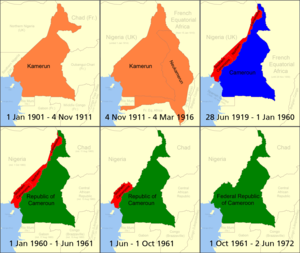British Cameroons: Difference between revisions
m Replace magic links with templates per local RfC and MediaWiki RfC |
Rescuing 1 sources and tagging 0 as dead. #IABot (v1.4.2) |
||
| Line 60: | Line 60: | ||
==External links== |
==External links== |
||
{{Commons category|British Cameroons}} |
{{Commons category|British Cameroons}} |
||
*[http://lucy.ukc.ac.uk/Chilver/Paideuma/paideuma-Introdu.html The road to the unitary state of Cameroon 1959-1972] |
*[https://web.archive.org/web/20060925063939/http://lucy.ukc.ac.uk/Chilver/Paideuma/paideuma-Introdu.html The road to the unitary state of Cameroon 1959-1972] |
||
*[http://www.getingetoutandgetaway.co.uk National Service Memoirs of a National Serviceman who served in the British Cameroons at the time of the vote to join with the French Cameroons or Nigeria] |
*[http://www.getingetoutandgetaway.co.uk National Service Memoirs of a National Serviceman who served in the British Cameroons at the time of the vote to join with the French Cameroons or Nigeria] |
||
Revision as of 02:03, 26 July 2017
This article relies largely or entirely on a single source. (April 2012) |
British Cameroons | |||||||||||
|---|---|---|---|---|---|---|---|---|---|---|---|
| 1922–1961 | |||||||||||
| Anthem: God Save the King/Queen | |||||||||||
| Status | Mandate of the United Kingdom | ||||||||||
| Capital | Buea | ||||||||||
| Common languages | English (official) Duaka, Oroko, Grassfields, Fula, Kanuri widely spoken | ||||||||||
| Religion | Christianity (southern area) Islam (northern area) | ||||||||||
| Historical era | World War I | ||||||||||
• Kamerun partitioned | July 20 1922 | ||||||||||
| October 1 1961 | |||||||||||
| Currency | British West Africa pound | ||||||||||
| ISO 3166 code | CM | ||||||||||
| |||||||||||
| Today part of | |||||||||||
British Cameroons was a British Mandate territory in British West Africa. Today, the territory forms parts of Northern Nigeria in West Africa and Cameroon in Central Africa.
History

The area of present-day Cameroon was claimed by Germany as a protectorate during the "Scramble for Africa" at the end of the 19th century.
League of Nations Mandate
During World War I, it was occupied by British, French and Belgian troops, and a later League of Nations Mandate to Great Britain and France by the League of Nations in 1922. The French mandate was known as Cameroun and the British territory was administered as two areas, Northern Cameroons and Southern Cameroons. Northern Cameroons consisted of two non-contiguous sections, divided by a point where the Nigerian and Cameroun borders met. In the 1930s, most of the white population consisted of Germans with Nazi sympathies[citation needed]; they were interned in British camps starting in June 1940. The native population of 400,000 showed little interest in volunteering for the British forces; only 3500 men did so.[1]
Independence
French Cameroun became independent, as Cameroun or Cameroon, in January 1960, and Nigeria was scheduled for independence later that same year, which raised question of what to do with the British territory. After some discussion (which had been going on since 1959), a plebiscite was agreed to, and held on 11 February 1961. The Muslim-majority Northern area opted for union with Nigeria, and the Southern area voted to join Cameroon.[2]
Northern Cameroons became a region of Nigeria on 31 May 1961, while Southern Cameroons became part of Cameroon later that year on 1 October 1961. In the meantime, the area was administered as a United Kingdom Trust Territory.
Governors
See also
References
- ^ I.C.B Dear, ed, The Oxford Companion to World War II (1995) p 163
- ^ Nohlen, D, Krennerich, M & Thibaut, B (1999) Elections in Africa: A data handbook, p177 ISBN 0-19-829645-2
External links
- The road to the unitary state of Cameroon 1959-1972
- National Service Memoirs of a National Serviceman who served in the British Cameroons at the time of the vote to join with the French Cameroons or Nigeria
- British Cameroons
- British West Africa
- History of Cameroon
- History of Nigeria
- Former British colonies and protectorates in Africa
- League of Nations mandates
- United Nations Trust Territories
- Former British protectorates
- Former colonies in Africa
- Cameroon–United Kingdom relations
- Nigeria–United Kingdom relations
- 1922 establishments in the British Empire
- 1922 establishments in Africa
- 1961 disestablishments in Africa



